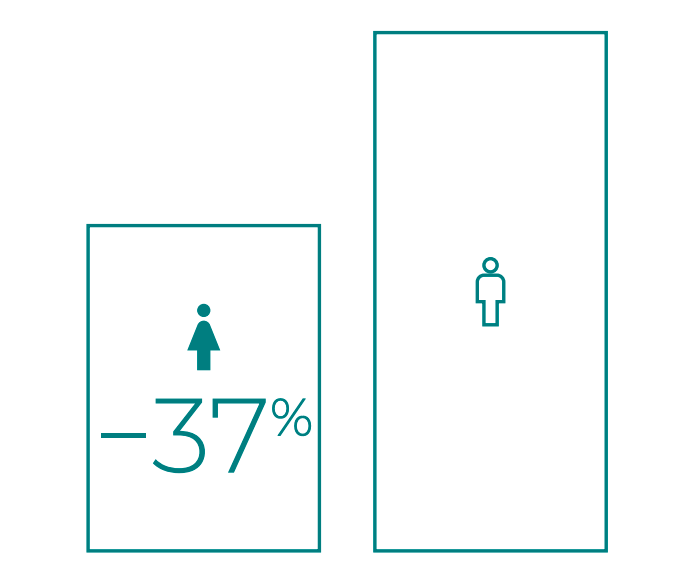
Author: Aniela Unguresan
Founder of EDGE Strategy and Founder of the EDGE Certified Foundation
Workplace gender equality is one of the keys to prosperous societies. It’s also central to sustainable business success, inclusive economic growth, and importantly, the health of the social fabric of an organization as well as a larger community. And yet, time and again, we underestimate its power to unlock hidden value and values.
The EDGE Certified Foundation, however, has formulated a theory of change of the ripple effects of workplace gender equality. We firmly believe that when change happens in the workplace, ripple effects follow and the efforts to build gender equal workplaces spill into the wider business practises of organizations. They filter though to how organizations work with business partners, how they invest, and how they build their supply chains.
Looking beyond the workplace, change can also spill over into the lives of people in general. We have seen how workplace gender equality can cascade down from a business community into the lives of employees.
It has become easier to advocate for workplace gender equality now than it was more than a decade ago when the EDGE Certified Foundation was founded. But this debate is often led by business cases and talks about the benefits for an organization and its business practises. However, the focus should also be on the benefits that gender equal workplaces bring to the lives of women in the workplace.
We believe that the workplace gender equality equation has three main components – the organization, the women working with that organization, and the men in the same workplace. For change to happen workplace gender equality needs to mean something concrete for each of the three components. This means that organizations on a gender equality journey need to have clear answers and be able to detail what are the specific benefits for each involved. In overview, organizations need to highlight and articulate why they are investing in gender equality, what the benefits are, and how workplace experiences, career paths and lives will in general improve.
As Robin Ely, Professor of Business Administration at Harvard Business School, so eloquently wrote in her 2020 article, ‘Getting Serious About Diversity: Enough Already with the Business Case’: “Why should anyone need an economic rationale for affirming the agency and dignity of any group of human beings? We should make the necessary investment because doing so honours our own and others’ humanity and gives our lives meaning.”
There are several tangible benefits for women and men that follow from organizations making prioritized, intentional, and measured efforts towards gender equality. And they revolve around markers such as increased income, improved working conditions, redistribution of care responsibilities, greater sense of self-worth and well-being, and in general, a shift to an equalized bargaining power within their households and within their communities.
Whenever we talk about the spill over effects it is true to say that some are more complex to measure than others. However, they are easy to quantify and the causal links easy to establish.
EDGE Certified organizations commit to provide assistance with childcare. They also make sure that in helping with childcare they make it equally available not just for women but for men as well.
Rising incomes
When organizations close gender pay gaps a number of employees, most often women, see their income increasing. This results in greater financial stability not just in the present, but in the long run as their investment and retirement capital potential increases. Such short-term and long-term financial stability can be directly attributed to closing the gender pay gap precisely because it makes available more disposable income for spending, investment and retirement.
This is a phenomenal positive effect of the pursuit for workplace gender equality.
With women globally earning around 37% less1 than men in similar roles, the differences between what a woman can buy and invest compared to a man are not only very consequential but also unfair.

Better access to childcare
A second benefit is equally significant – greater access to childcare and a redistribution of care responsibilities.
This is because such responsibilities directly affect a woman’s career trajectory and income; women are less likely to put in long hours and are more likely to take leave to care for children or sick family members. They are also much more likely to take career breaks.
Organizations pursuing gender equity know that supporting a redistribution of care responsibility is key for women’s career prospects and income.
EDGE Certified organizations commit to provide assistance with childcare. They also make sure that in helping with childcare they make it equally available not just for women but for men as well.
So, next time when you apply for a job, ask what the organization is doing to achieve workplace gender equality.
Redefined gender roles
Such organizations also provide for equal, if not very comparable, lengths of paid paternity and maternity leave – a third benefit. But they go further and ensure that fathers are actively encouraged to take the full length of paid paternity leave available to them.
This not only allows women to have smoother career trajectories, but it also allows men to have the same type of ‘stop and go’ careers as women, helping to level the playing field. Plus, from the outset, this sends signals that parental leave is not a gender issue, it is a parental issue.
And this is how beneficial paternity leave can be. Fathers that took leave after birth believe this was directly responsible for their greater involvement in the ongoing care of their child compared to those that didn’t. They also believe that paternity leave led to improvements in the quality of family life2.
But let’s not forget that women with children who work are termed ‘working mothers’. Men in the same situation are not, however, called ‘working fathers’. Instead, they are called ‘professional men’. By not allowing fathers to be termed ‘working’ they risk losing their entitlement to take parental leave.
The solution lies in creating support groups for working fathers where senior management discuss the role of the working father; doing this equalizes the concept of working men with that of a working mother.
And so, with more women in positions of power and authority, more men will be in support roles, or working part time, more equally shared care responsibilities, and we will all learn to rip off the straitjacket of traditional gender roles from work and the home.
So, next time when you apply for a job, ask what the organization is doing to achieve workplace gender equality. Your career development prospects, whether you are a man or a woman, will be very different depending on what the answer is. Next time you decide to invest in a company, or buy products and services from a company, ask what they do to ensure women and men thrive in the workplace. The prosperity of our economy and well-being of our society depends on it.
1Global Gender Gap Report 2021 – World Economic Forum
2Ellison et al., 2009. 56% of British fathers who took Paternity Leave believe this was directly responsible for their greater involvement in the care of their children in the longer term; and 69% said it led to improvements in the quality of family life.
Download PDF





